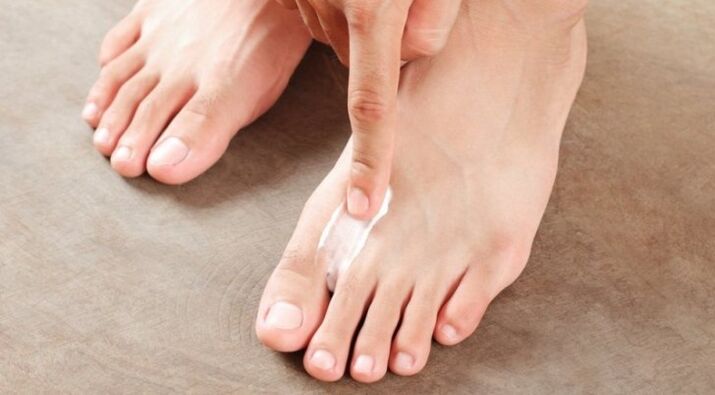Intolerable itching and redness of the skin between the toes, cutting pains when walking are the first symptoms of the most common dermatological problem - fungal skin lesions. Germinating through the delicate epithelium of the skin, the mycelium of the fungus gradually "spreads" over the entire plantar surface of the legs, causing unpleasant wet and flaky areas, painful cracks and deformation of nails.

Malignant fungus and related factors
The causative agent of the disease is dermatomycete fungi, among which the genus Trichophyton is considered the most common. They live almost everywhere - in pools and on beaches, in people's shoes and on animal hair, but the disease is not always provoked. An important factor is the creation of an infection gate through which the dermatomycete can penetrate to a sufficient depth.
The fungus between the toes appears when the barrier functions of the skin are weakened:
- When wearing tight, closed shoes. This is especially true for the hot season, when the sweat released creates conditions for maceration of the skin, becomes the abode of many microorganisms.
- Abrasions and scratches are ready gates for the entry of fungus. If you have them, you should not risk trying on someone else's shoes on bare feet, walking barefoot in the pool, sauna and steam bath.
- An effective remedy for the fungus on the feet between the toes has to be looked for by lovers of cheap pedicure in salons with dubious fame. The procedure itself involves cutting the cuticles and scrubbing the skin, and non-sterile instruments may well be "enriched" with fungus.
Fungus between the toes: symptoms and complications
It is impossible to describe unequivocally what the fungus looks like on the legs between the toes, since the disease has several forms, each of which is characterized by special manifestations:
- Dyshidrotic foot fungus is characterized by three stages - redness, the formation of bubbles with liquid and drying crusts, peeling. As a rule, all three phases coexist on the same areas of the skin. The insidiousness of the dyshidrotic form of dermatomycosis lies in its high similarity with eczema. For an accurate diagnosis, a laboratory smear test is required.
- The squamous form is characterized by redness and severe flaking of the skin.
- Squamous-hyperkeratotic lesion causes severe itching and burning, seals and scales of peeling appear a little later.
- With the intertriginous form, the manifestations are so typical that you do not even have to look at what the fungus looks like between the toes in the photo: severe itching, burning are accompanied by peeling and the formation of painful cracks, and quite large foci of epidermal exfoliation often appear.
- Intertriginous and dyshridrotic forms of dermatomycosis require caution and delicate methods of treatment, because secondary microflora can easily penetrate into weeping foci and cracks, which will lead to the appearance of abscesses. Despite the chronic course, they have pronounced inflammatory processes, which requires the use of emollient ointments and anti-inflammatory baths.
Drug treatment
In the arsenal of modern medicine, there are a number of drugs for the treatment of fungus between the toes. Among them there are both topical ointments and tablets that destroy the fungus from the inside. As a rule, a specialist selects a drug based on an analysis of the degree of development of the disease, its form and coverage. Systemic therapy using tablets is used only in advanced cases, when the skin of the entire foot is involved in the process and characteristic changes in the nail plates are found.
Antifungal ointments are divided over several generations. But, it should be understood that even the most effective remedy for the fungus between the toes does not guarantee disposal if you neglect the rules of personal hygiene and a number of precautions.
Throughout the treatment, a gentle pedicure should be performed at least once a week. Subsequently, the frequency can be reduced to once every two weeks.
Since the fungus can survive on socks and shoes, they also need to be treated. To do this, use chlorine-containing liquids, such as bleach.
If you are thinking about how to get rid of fungus between your toes, remember to change your socks every day. For two or three days in a row, wearing clothes already retains traces of sweat, in which the parasites live and multiply.
Only a combination of a course of therapy selected by a specialist and careful observance of all hygiene rules can guarantee a quick recovery from the disease.
Treatment of the fungus between the toes with folk remedies
Traditional medicine has collected a lot of recipes for combating fungus, including both remedies from kitchen cabinets and very exotic herbs and medicines. The most accessible among them are:
- Iodine, daily lubrication of lesions with which brings visible results in a week.
- Hydrogen peroxide, which gained popularity thanks to the works of a famous doctor. Its ability to destroy the cell membranes of the fungus and form a film on the surface of the damaged skin guarantees quick relief from the disease.
If you have gone over a lot of funds and are thinking how to treat the fungus between your toes, then you should also try the effect of vinegar. Despite the fungus living in a slightly acidic environment, it does not tolerate an increase in pH. Lubrication of the affected areas with a solution of 9% vinegar and water in a ratio of 1: 8 gives positive results within 2-3 weeks.
The most popular remedies in folk medicine - onions and garlic - also have antifungal effect. The gruel made from them is mixed with petroleum jelly in a 1: 1 ratio and applied to the affected skin before going to bed.
You have not decided how to treat the fungus on the feet between the toes, do not forget about its destruction on shoes and personal hygiene items. This is what guarantees the absence of relapses in the very near future.





























